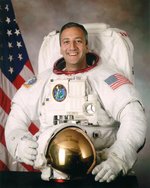Michael J. Massimino
|
|
Michael J. Massimino (Ph.D)
NASA Astronaut
| Contents |
Personal data
Born August 19, 1962 in Oceanside, New York. His hometown is Franklin Square, New York. Married. He enjoys baseball, family activities, home improvement projects, camping, and coaching kids' sports.
Education
- 1980: Graduated from H. Frank Carey High School, Franklin Square, New York
- 1984: Received a bachelor of science degree in industrial engineering with honors from Columbia University
- 1988: Received a master of science degrees in mechanical engineering from the Massachusetts Institute of Technology (MIT)
- 1990: Received a mechanical engineering degree in technology and policy from the Massachusetts Institute of Technology (MIT)
- 1992: Received a doctorate in mechanical engineering from the Massachusetts Institute of Technology (MIT)
Organizations
- MIT Alumni Association
- Columbia University Alumni Association
- Association of Space Explorers.
Special honors
- NASA Space Flight Medal
- NASA Graduate Student Researchers Program Fellowship
Experience
Upon completing his B.S. degree from Columbia University, Massimino worked for IBM as a systems engineer in New York City from 1984 until 1986. In 1986 he entered graduate school at the Massachusetts Institute of Technology where he conducted research on human operator control of space robotics systems in the MIT Mechanical Engineering Department's Human-Machine Systems Laboratory. His work resulted in the awarding of two patents. While a student at MIT he worked during the Summer of 1987 as a general engineer at NASA Headquarters in the Office of Aeronautics and Space Technology, during the summers of 1988 and 1989 as a research fellow in the Man-Systems Integration Branch at the NASA Marshall Space Flight Center, and during the summer of 1990 as a visiting research engineer at the German Aerospace Research Establishment (DLR) in Oberpfaffenhofen, Germany. After graduating from MIT in 1992, Massimino worked at McDonnell Douglas Aerospace in Houston, Texas as a research engineer where he developed laptop computer displays to assist operators of the Space Shuttle remote manipulator system. These displays included the Manipulator Position Display, which was evaluated on STS-69. From 1992 to 1995 he was also an adjunct assistant professor in the Mechanical Engineering & Material Sciences Department at Rice University, where he taught feedback control of mechanical systems. In September 1995, Massimino joined the faculty of the Georgia Institute of Technology as an assistant professor in the School of Industrial and Systems Engineering. At Georgia Tech he taught human-machine systems engineering classes and conducted research on human-machine interfaces for space and aircraft systems in the Center for Human-Machine Systems Research, and is currently an Adjunct Assistant Professor at Georgia Tech. He has published papers in technical journals and in the proceedings of technical conferences.
NASA experience
Selected as an astronaut candidate by NASA in May 1996, Massimino reported to the Johnson Space Center in August 1996. He completed two years of initial training and evaluation and is qualified for flight assignment as a mission specialist. Prior to his first space flight assignment, Massimino served in the Astronaut Office Robotics Branch, and in the Astronaut Office Extravehicular Activity (EVA) Branch. In March 2002, Massimino flew on STS-109 and has logged over 10 days in space, including 2 EVAs (spacewalks) totaling 14 hours and 46 minutes. He currently serves as a CAPCOM (spacecraft communicator) in Mission Control and performs other technical tasks in the Astronaut Office CAPCOM Branch.
Space flight experience
STS-109 Columbia (March 1-12, 2002). STS-109 was the fourth Hubble Space Telescope (HST) servicing mission. The crew of STS-109 successfully upgraded the Hubble Space Telescope leaving it with a new power unit, a new camera (the Advanced Camera for Surveys), and new solar arrays. STS-109 set a record for spacewalk time with 35 hours and 55 minutes during 5 spacewalks. Massimino performed 2 spacewalks totaling 14 hours and 46 minutes. STS-109 orbited the Earth 165 times, and covered 4.5 million statute miles in over 262 hours and 10 minutes.
JANUARY 2003
Source: [1] (http://www.jsc.nasa.gov/Bios/htmlbios/massimin.html)
- REDIRECT Template:PD-USGov-NASA

